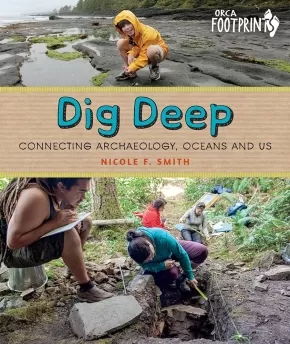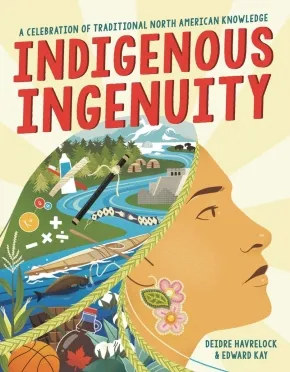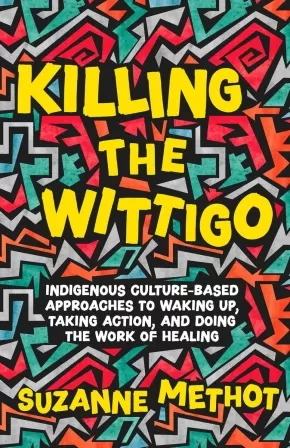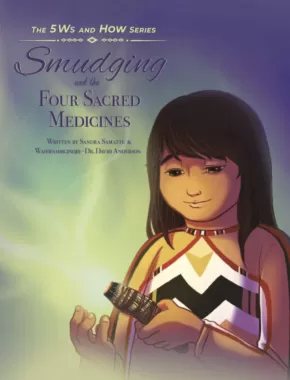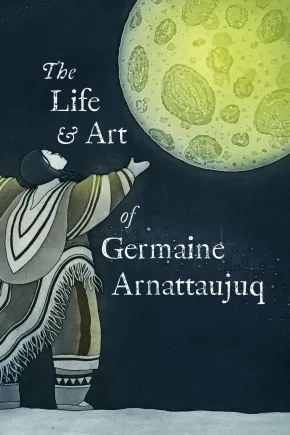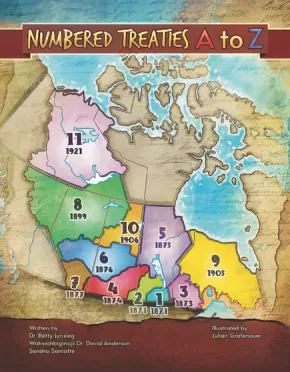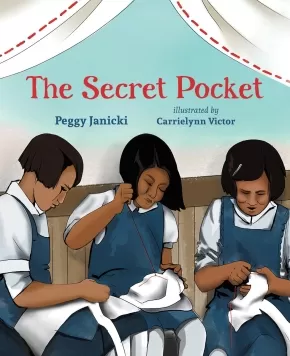
Indigenous Peoples in Canada
61
-
75
of
326 Results;
Sort By
Go To
of 22
Dig Deep: Connecting Archaeology, Oceans and Us
$21.95
Format:
Hardcover
Text Content Territories:
Indigenous; Indigenous Canadian; First Nations; Indigenous American; Native American;
ISBN / Barcode: 9781459826083
Synopsis:
Synopsis:
What can archaeology and Indigenous Traditional Knowledge tell us about how our marine environments have changed over time and the effects of climate change?
From harvesting herring eggs to hunting humpback whales, humans have had a relationship with the world's oceans for more than 100,000 years. In Dig Deep: Connecting Archaeology, Oceans and Us, young readers unearth what our ancestors left behind at archaeological sites around the world and examine how tools, campsites, fishing technologies and even garbage can show us how our ancestors lived and how they used the ocean. These discoveries can unearth clues to help keep our oceans healthier today and in the future.
Reviews
“Provides readers with an introduction to archeology…Slim yet informative…Recommended.” — School Library Connection
Educator & Series Information
Recommended for ages 9 to 12.
This book is part of the Orca Footprint series.
Additional Information
48 pages | 8.00" x 9.50" | Hardcover
Every Child Matters
$24.99
Format:
Hardcover
Text Content Territories:
Indigenous Canadian; First Nations; Inuit; Métis;
ISBN / Barcode: 9781778540165
Synopsis:
Synopsis:
Learn the meaning behind the phrase, ‘Every Child Matters.'
Orange Shirt Day founder, Phyllis Webstad, offers insights into this heartfelt movement.
Every Child Matters honours the history and resiliency of Indigenous Peoples on Turtle Island and moves us all forward on a path toward Truth and Reconciliation.
If you're a Residential School Survivor or an Intergenerational Survivor - you matter. For the children who didn't make it home - you matter. The child inside every one of us matters. Every Child Matters.
Reviews
"Every Child Matters speaks to all Indigenous Peoples - past and present - whose lives have been impacted by the residential school system. Phyllis and Karlene beautifully honour the unity, strength and resolve shared by Survivors, their families and their communities. Residential schools took our children and tried to break their vibrant spirits. With this book, the children of today can learn the truths of this history and how they can play a part in making sure every child matters." – Stephanie Scott, Executive Director of the National Center for Truth and Reconciliation
“…a brilliantly illustrated and meticulously written narrative. It is a must read.” - Chief Dr. Robert Joseph, Gwawaenuk, Elder, Reconciliation Canada
Educator Information
Recommended for ages 6 to 10.
Find the accompanying Teacher Lesson Plan resource HERE!
This book is available in French: Chaque enfant compte
Additional Information
44 pages | 8.50" x 11.00" | Hardcover
Haywaas' Question: What Is Reconciliation?
$16.95
Format:
Paperback
Text Content Territories:
Indigenous Canadian; First Nations; Haida;
ISBN / Barcode: 9781738736706
Synopsis:
Synopsis:
After Haywaas sees his parents get frustrated while watching the news, this precocious 12-year-old begins a months-long journey navigating many different answers to what he thought was a simple question.
Expertly crafted by a teacher-parent-author duo, Haywaas’ Question is relatable, understandable, and aptly builds up to an answer we’re all a part of.
Educator Information
The publisher recommends this picture book for Grades 4 - 10.
This book is available in French: La Question de Haywaas: Qu'est-ce que la réconciliation?
Additional Information
36 pages | 7.00" x 9.00" | Paperback
Indigenous Ingenuity: A Celebration of Traditional North American Knowledge (PB)
$12.99
Artists:
Format:
Paperback
ISBN / Barcode: 9780316413435
Synopsis:
Synopsis:
Celebrate Indigenous thinkers and inventions with this beautifully designed, award-winning interactive nonfiction book—perfect for fans of Braiding Sweetgrass.
Corn. Chocolate. Fishing hooks. Boats that float. Insulated double-walled construction. Recorded history and folklore. Life-saving disinfectant. Forest fire management. Our lives would be unrecognizable without these, and countless other, scientific discoveries and technological inventions from Indigenous North Americans.
Spanning topics from transportation to civil engineering, hunting technologies, astronomy, brain surgery, architecture, and agriculture, Indigenous Ingenuity is a wide-ranging STEM offering that answers the call for Indigenous nonfiction by reappropriating hidden history. The book includes fun, simple activities and experiments that kids can do to better understand and enjoy the principles used by Indigenous inventors. Readers of all ages are invited to celebrate traditional North American Indigenous innovation, and to embrace the mindset of reciprocity, environmental responsibility, and the interconnectedness of all life.
Reviews
"An astonishing, exuberant treasure trove of history, science and hands-on activities that repeatedly begs the question: "Why didn't I know this?" Essential for kids and adults. We need this book." —Candace Fleming, award-winning author of The Rise and Fall of Charles Lindbergh and The Family Romanov
"This book will amaze readers and teachers as it demonstrates how pervasive and critical the history of Indigenous people is. A completely unique and important narrative not to be missed; readers and teachers will come away with a new appreciation for the myriad contributions Indigenous people have made."—SLJ, starred review
"A conversational tone invites readers to engage with this monumental collection . . . Curious readers will learn facts unique to individual tribal groups while gaining knowledge of STEM/STEAM concepts. An ambitious, appealing, and accessible work documenting and protecting valuable knowledge."—Kirkus Reviews
"Engaging and informative, this will be welcomed by both STEM and social studies curricula to help to correct prevailing narratives about Indigenous technology."—Booklist, starred review
"Via authoritative, meticulously researched prose, the creators detail Native peoples’ significant strides in scientific pursuits . . . [and] showcase Native tribes’ continual and enduring impact. Photographs, as well as interactive activities detailing recipes and science experiments, feature throughout, lending a hands-on approach to this clear and concise work."—Publishers Weekly
"This book is a valuable contribution to efforts to decolonize learning and introduce readers to the breadth of indigenous knowledge as practiced in widely disparate geographic zones."—Canadian Review of Materials
"An engaging and cleverly compiled guide to North American and Mesoamerican Indigenous innovation. STEM topics (housing, medicine, clothing, agriculture, and hunting among them) are compellingly and conversationally discussed."—Shelf Awareness
Educator Information
Recommended for ages 8 to 12.
Fountas & Pinnell Text Level Gradient: Z
Additional Information
288 pages | 6.95" x 9.00" | Paperback
Killing the Wittigo: Indigenous Culture-Based Approaches to Waking Up, Taking Action, and Doing the Work of Healing
$29.95
Format:
Paperback
ISBN / Barcode: 9781770417243
Synopsis:
Synopsis:
An unflinching reimagining of Legacy: Trauma, Story, and Indigenous Healing for young adults.
Written specifically for young adults, reluctant readers, and literacy learners, Killing the Wittigo explains the traumatic effects of colonization on Indigenous people and communities and how trauma alters an individual’s brain, body, and behavior. It explores how learned patterns of behavior — the ways people adapt to trauma to survive — are passed down within family systems, thereby affecting the functioning of entire communities. The book foregrounds Indigenous resilience through song lyrics and as-told-to stories by young people who have started their own journeys of decolonization, healing, and change. It also details the transformative work being done in urban and on-reserve communities through community-led projects and Indigenous-run institutions and community agencies. These stories offer concrete examples of the ways in which Indigenous peoples and communities are capable of healing in small and big ways — and they challenge readers to consider what the dominant society must do to create systemic change. Full of bold graphics and illustration, Killing the Wittigo is a much-needed resource for Indigenous kids and the people who love them and work with them.
Educator Information
Recommended for ages 12 to 17.
The adult version of this book can be found here: Legacy: Trauma, Story, and Indigenous Healing
Additional Information
160 pages | 5.50" x 8.50" | Paperback
Nutshimit: In the Woods
$22.99
Artists:
Format:
Hardcover
Text Content Territories:
Indigenous Canadian; First Nations; Innu (Montagnais-Naskapi); Ekuanitshit; Inuit; Métis;
ISBN / Barcode: 9781039701809
Synopsis:
Synopsis:
In this immersive first-person account, Innu author Melissa Mollen Dupuis teams up with award-winning author and illustrator Elise Gravel to take readers on a journey through Innu culture, from creation legends to life today.
The Innu word Nutshimit signifies the physical and social space to practice traditional activities and language. Join author Melissa Mollen Dupuis on a guided walk deep through the forest to learn some of the rich culture of the Innu people.
Readers will discover the importance of natural world and learn a few Innu words along the way. Thoughtfully brought to life by Elise Gravel’s signature comic style illustrations, Melissa’s colloquial narrative and anecdotes detailing her lived experiences offer a deeply personal look at Innu life.
Educator Information
Recommended for ages 6 to 8.
Children learn Innu nature vocabulary through anecdotes from author’s lived experiences.
Populated with Elise Gravel’s hilarious characters and plenty of fun details.
This book is available in French: Nutshimit: Un bain de forêt
Find an activity book for this title here: Nutshimit: Activity Book
Additional Information
88 pages | 8.00" x 11.00" | Hardcover
Orange Shirt Day: September 30th: Revised Edition
$32.99
Format:
Hardcover
Text Content Territories:
Indigenous Canadian; First Nations; Inuit; Métis;
ISBN / Barcode: 9781778540141
Synopsis:
Synopsis:
Orange Shirt Day, observed annually on September 30th, is also known as the National Day for Truth and Reconciliation. It is an official day to honour Residential School Survivors and their families, and to remember the children who did not come home. What was initially envisioned as a way to keep the conversations going about all aspects of Residential Schools in Williams Lake and the Cariboo Region of British Columbia, Canada, has now expanded into a movement across Turtle Island and beyond. Orange Shirt Day: September 30th aims to create champions who will walk a path of reconciliation and promote the message that 'Every Child Matters'. This award-winning book explores a number of important topics including the historical, generational, and continual impacts of Residential Schools on Indigenous Peoples, the journey of the Orange Shirt Day movement, and how you can effectively participate in the National Day for Truth and Reconciliation. With end of chapter reflection questions and a series of student art submissions, readers are guided to explore how they, and others, view and participate in Residential School reconciliation.
Awards
- 2021 First Nation Communities Read 2021 Winner
Educator Information
Recommended Ages: 10+
Orange Shirt Day was inspired by the story of a survivor named Phyllis Webstad. When Phyllis was 6 years old she went to residential school for the first time wearing a brand new shiny orange shirt. When she arrived at the school her shirt was taken away and never to be seen again. To Phyllis the colour orange was a symbol that she did not matter. Today she has learned to accept the colour and even have fun with it and now the orange shirt has become a symbol of hope and reconciliation. By wearing an orange shirt on Orange Shirt Day, you make a powerful statement that residential schools were wrong and commit to the concept that EVERY CHILD MATTERS.
The Orange Shirt Society is a non-profit organization with its home in Williams Lake, BC where Orange Shirt Day began in 2013. The society has both Indigenous and non-Indigenous board members, and one of the editors of this book, Phyllis Webstad, is Indigenous. Therefore, the Authentic Indigenous Text label has been applied. It is up to readers to determine if this book is authentic for their purposes.
This is the Revised 2023, 2nd Edition
Additional Information
156 pages | 8.23" x 11.06" | Revised, 2nd Edition
Powwow Dancing With Family (PB)
 $16.95
$16.95

Artists:
Format:
Paperback
Text Content Territories:
Indigenous Canadian; First Nations; Salish; Interior Salish; Secwepemc (Shuswap);
ISBN / Barcode: 9781771746281
Synopsis:
Synopsis:
Drumming, singing, and dancing are all part of being at a Powwow. Perry and his family travel all over North America to participate in these family and community gatherings. Join Perry’s two boys as they share their treasured memories of being at Powwows with their family and learning how to dance.
Reviews
“Lavishly illustrated with photographs, vivid sketches, and ledger art, Powwow Dancing With Family provides a detailed description of each stage of the Powwow, historical and contemporary aspects of the Powwow, and pays homage to Indigenous culture and customs. This informative resource will support studies of Indigenous culture, history, traditions, community, art, and family lifestyle.” – ERAC Review, May 2019
Educator Information
Includes three pages of educational material on Powwows with information found under these headings:
- What is a Powwow?
- Powwow Regalia
- Powwow Dances
About Perry Smith's Ledger Art:
Ledger Art is an art form that was developed in the mid 1800s to early 1900s by the Plains First Nations during a time when reserves were being established across North America. The ledger books were acquired in trade, war, or raids. New art supplies were also introduced: coloured pencils, crayons, and occasionally water paints. The new supplies were favoured by artists over the traditional bone and stick brushes. Many of the artworks within these ledger books display a traditional way of life, before assimilation. Today these artworks are greatly valued for the historical perspective that they offer.
Additional Information
32 pages | 8" x 8" | ISBN: 9781771746281 | Paperback
Rise Up and Sing!: Power, Protest, and Activism in Music
$26.95
Artists:
Format:
Hardcover
Text Content Territories:
Indigenous Canadian; Indigenous;
ISBN / Barcode: 9781771648981
Synopsis:
Synopsis:
This inspiring introduction to activism and social justice for young teens shows the important role music plays in changing the world, featuring:
- Musicians young teens will know and love: Beyoncé, Billie Eilish, Lizzo, Lady Gaga, Lil Nas X, and more!
- Iconic artists from past generations: readers will learn about the extraordinary impact of artists such as Nina Simone, Buffy Sainte-Marie, Neil Young, John Lennon, Bob Dylan, Tracy Chapman, and more.
- Playlists for each social justice issue: Each chapter includes a playlist with recommended songs about an area of activism, from classic tracks to contemporary hits.
In Rise Up and Sing!, Andrea Warner explores how music has contributed to the fight for social justice. Across eight areas of activism—the climate emergency, Indigenous rights, civil rights, disability rights, 2SLGBTQIA+ rights, gender equality, the peace/anti-war movement, and human rights—Warner introduces some of the artists, past and present, who have made a difference both on stage and off.
Through ground-breaking artists and iconic moments, Rise Up and Sing! shows us that a song is never just a song, and that music really does have the power to change the world.
Educator Information
Recommended for ages 12 to 17.
Includes some Indigenous content.
Curriculum Connections: Activism, Social Justice, Music
Additional Information
200 pages | 7.00" x 9.00" | Hardcover
Seagull Island: kiyāsko-miniscikos
$22.95
Artists:
Format:
Hardcover
Text Content Territories:
Indigenous Canadian; First Nations; Cree (Nehiyawak); Woodland Cree;
ISBN / Barcode: 9781778690105
Synopsis:
Synopsis:
“waniskā. wāpan,” mosōm says. “Wake up. It’s morning, little one. You, me, and kohkom are going for a boat ride for the day.”
And that is exactly what they do in this quiet book that celebrates traditional life in modern times. Held warmly in his kohkom’s arms, little Luke watches ducks, pelicans and cormorants on the way to Seagull Island, where the family collects eggs for their shore lunch and to share later with Auntie at home.
Seagull Island: kiyāsko-miniscikos is inspired by Elder Myles Hector Charles’s memories of gathering eggs with his grandson Luke in northern Saskatchewan.
Written in English with Woodland Cree words and phrases, the story and illustrations show the deep connection between families and the land.
Educator Information
Recommended for ages 5 to 10.
Written in English with Woodland Cree words and phrases.
Additional Information
24 pages | 9.00" x 9.00" | Hardcover
Smudging and the Four Sacred Medicines
$24.95
Format:
Hardcover
Text Content Territories:
Indigenous Canadian;
ISBN / Barcode: 9781990297557
Synopsis:
Synopsis:
The 5 Ws and How Series has been created to help All of Us learn and understand who we are, as Indigenous Peoples across Turtle Island.
The first book in this series, Smudging and the Four Sacred Medicines, will guide you as you learn about Sacred Medicines and Smudging. Learn how Smudging helps us stay strong and connected to All of Creation. Indigenous Peoples have always Smudged and use Sacred Medicines in Ceremony, for Healing, and in daily life. This book shows which Medicines to use in a Smudge, how to Respect the Spirit of the Medicines when Smudging, and reminds us that Smudging is for Everyone!
Educator & Series Information
Recommended for grades 2 to 5.
This book is part of The 5 Ws and How Series.
Includes information about who, where, how, and when to smudge.
Shares information about the four sacred medicines (tobacco, sweetgrass, sage, cedar).
Additional Information
20 Pages | Hardcover
The Life and Art of Germaine Arnattaujuq
$15.95
Artists:
Format:
Paperback
Text Content Territories:
Indigenous Canadian; Inuit;
ISBN / Barcode: 9781774506462
Synopsis:
Synopsis:
Uncover the incredible life story of Germaine Arnattaujuq, a singularly important Inuit artist, in this high interest/low reading level reference book for struggling readers.
Germaine Arnattaujuq is an award-winning Inuit artist. This book tells the story of her life, from growing up at a camp in Nunavut to her education as an artist in Winnipeg and Ottawa and her eventual return to the North. Germaine's incredible drawings, etchings, and illustrations are featured throughout the book, along with archival photographs.
Filled with personal anecdotes and fun facts, this book encourages reluctant readers to discover how Germaine started drawing on gum wrappers as a child and went on to become one of the most well-known artists from the North.
Educator Information
Recommended for ages 12 to 18.
This is a Hi-Lo (high-interest, low readability) book.
Additional Information
60 pages | 6.00" x 9.00" | Colour Photographs | Paperback
The Numbered Treaties A to Z
$24.95
Artists:
Format:
Paperback
Text Content Territories:
Indigenous Canadian;
ISBN / Barcode: 9781990297342
Synopsis:
Synopsis:
Let us walk together through the ABCs of the Numbered Treaties. We purposefully use the ABC, a constructed Language system from the English Language, to talk back to the Numbered Treaties, so named without reference to our Own Language system or the Land.
First Nations People entered into Treaties and Agreements prior to Confederation and negotiated the Numbered Treaties after the Confederation of Canada in 1867.
Educator Information
Recommended for grades 4 to 6.
Additional Information
Paperback
The Origin of Day and Night (PB)
$13.95
Artists:
Format:
Paperback
Text Content Territories:
Indigenous Canadian; Inuit;
ISBN / Barcode: 9781772274691
Synopsis:
Synopsis:
In very early times, there was no night or day and words spoken by chance could become real. When a hare and a fox meet and express their longing for light and darkness, their words are too powerful to be denied. Passed orally from storyteller to storyteller for hundreds of years, this beautifully illustrated story weaves together elements of an origin story and a traditional animal tale, giving young readers a window into Inuit mythology.
Educator Information
Recommended in a Canadian Indigenous Books for Schools resource list as being useful for grades 2-5 in these subject areas: English Language Arts, Social Studies.
Useful as a read-aloud, independent read, or information resource for students.
Additional Information
32 pages | 9.00" x 8.00" | Paperback
The Secret Pocket
$21.95
Artists:
Format:
Hardcover
Text Content Territories:
Indigenous Canadian; First Nations; Dene; Dakelh (Carrier);
ISBN / Barcode: 9781459833722
Synopsis:
Synopsis:
The true story of how Indigenous girls at a Canadian residential school sewed secret pockets into their dresses to hide food and survive
Mary was four years old when she was first taken away to the Lejac Indian Residential School. It was far away from her home and family. Always hungry and cold, there was little comfort for young Mary. Speaking Dakelh was forbidden and the nuns and priest were always watching, ready to punish. Mary and the other girls had a genius idea: drawing on the knowledge from their mothers, aunts and grandmothers who were all master sewers, the girls would sew hidden pockets in their clothes to hide food. They secretly gathered materials and sewed at nighttime, then used their pockets to hide apples, carrots and pieces of bread to share with the younger girls.
Based on the author's mother's experience at residential school, The Secret Pocket is a story of survival and resilience in the face of genocide and cruelty. But it's also a celebration of quiet resistance to the injustice of residential schools and how the sewing skills passed down through generations of Indigenous women gave these girls a future, stitch by stitch.
Awards
- 2023 Sunshine Coast Writers and Editors Society (SCWES) Book Awards for BC Authors joint winner
- 2024 Forest of Reading Silver Birch Express Award
Reviews
“In bringing her mother’s story to the world, Peggy Janicki has ignited a powerful fire for intergenerational healing. A vivid illustration of how Traditional Knowledge helped the children at residential schools be heroes for themselves and each other. Not only has Janicki meticulously documented everyday life as experienced by the students of the Lejac residential school but she has also highlighted their ingenious and courageous efforts to survive. Strengths-based, age-appropriate and vividly engaging.”— Christy Jordan-Fenton, award-winning author of Fatty Legs
“Beautifully illustrated and powerfully narrated, The Secret Pocket amplifies the voices and experiences of Indian Residential School Survivors. In doing so, Peggy Janicki and Carrielynn Victor make an important contribution to the work of putting truth before reconciliation.”— Sean Carleton, historian and author of Lessons in Legitimacy: Colonialism, Capitalism, and the Rise of State Schooling in British Columbia
“In this important story of courage and resistance, educator Peggy Janicki shares the story of her mother and other Survivors who sewed secret pockets into their dresses to hide food to feed themselves and others at Lejac residential school. We need to continue to hear these stories and share them with our children so we can move forward in our collective healing.”— Dr. Sara Florence Davidson, co-author of Potlach as Pedagogy: Learning Through Ceremony
“It is through stories that knowledge, understanding, empathy and the tools for deep and lasting change are passed on. Peggy Janicki has carried her mother’s story for us to hold in our hearts. This truth-telling and history-sharing will touch readers of all ages as they allow themselves to feel the weight of this powerful book.”— Amber Price, MGC, owner of The Book Man
Educator Information
Recommended for ages 6 to 8.
This book is available in French: La poche secrète.
Additional Information
32 pages | 8.75" x 10.75" | Hardcover
Sort By
Go To
of 22

